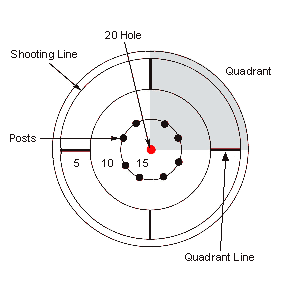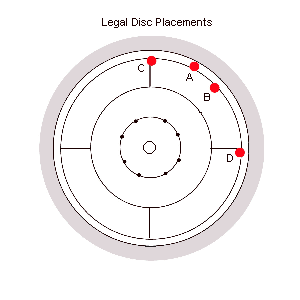


home for-sale how-we-build crokinole crokinole-gallery about-us crokinole-rules scoring variants
It is believed that the game of crokinole originated in Canada in the 1800s. Many variations of the game have existed; the rules below are the commonly accepted ones.
The standard crokinole board consists of a 26-inch diameter playing surface surrounded by a two-inch wide ditch. The playing surface is divided into quadrants (gray area in diagram below) defined by the quadrant lines. For scoring purposes, the board has a center hole which scores 20 points. Surrounding the 20-hole is a ring eight inches in diameter. This ring scores 15 points. There are eight posts of metal, wood or some other material on the 15 circle. The next ring is 16 inches in diameter and scores 10 points. The third ring at 24 inches in diameter scores five points. The third ring is known as the shooting line. There is one inch between the shooting line and the ditch; no points are scored for any disc in this ring.

The object of the game is to propel your disks with a flicking motion into the scoring rings. It is much like shuffleboard or curling, where the object is to knock your opponent's pieces off the board or into lower scoring rings while keeping yours in the higher scoring rings. Once all discs have been shot, each player adds up his points, and the player with the greater number of points scores the difference between the two. For example, if the red player has 55 points and the black player has 30, the red player scores 25 points (55-30), and the black player scores zero. The game continues until one player reaches 100 points.
In a two-player game, players shoot from opposite quadrants. The players will shoot 12 discs, alternating shots. In four-player games, team members sit opposite each other, and each player shoots six discs. Play continues clockwise around the table with each player shooting one disc in turn.
To start the game, the first player places his disc anywhere on the starting line in his quadrant. The disc must touch the starting line; A disc at either end of the quadrant may hang over the quadrant line as long as it touches it and the shooting line. The player then propels the disc toward the center of the board with a finger flick.

In the diagram to the right, A and B are legal placements for a shot because they touch the shooting line. C and D are legal because they touch the starting line and the quadrant line in the northeast quadrant. (One popular rule variant says a disc must be no more than halfway over the quadrant line, so D would be illegal with that rule.)
If the disc stops within the 20 hole (it must be completely within the hole and not hanging or leaning in it), it is immediately removed from the board and set aside for scoring at the end of the round. The opposing player will then take his shot, attempting to score a 20.
If a player does not score a 20, his turn ends, and his opponent now shoots. The second shooter must contact at least one of his opponent's pieces on his shot. If he fails to do so, his piece is immediately removed from the board and is placed in the ditch, where it will score no points. Play continues until all discs have been shot.
More rules and scoring